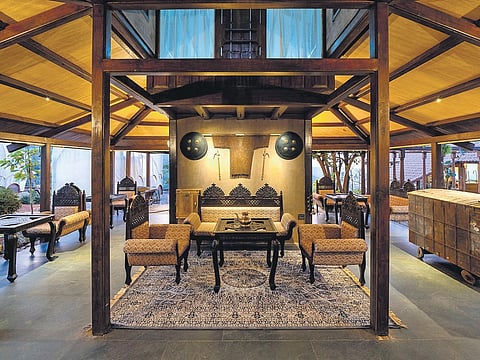

At The Chavni, the soft golden hue of the setting sun welcomes guests to the high tea area, set against the backdrop of the Sahyadris. Two forts—Lohagad and Visapur—loom large. Lohagad had been the proud conquest of Chhatrapati Shivaji Maharaj. Tents and bullock carts stand nearby as Saraswati, the horse, neighs in the distance. As night falls, a man clad in dhoti-kurta lights the mashals outside the tents, as canvased roofs of the caravans flutter in the light wind. The whole set-up seems straight out of the 17th-century Maratha era when travellers and soldiers camped for the night in the chhavani (transit site) of a sardar (chieftain).
A 1.5-hour drive from Pune, the road to Lohagad is a series of sharp bends from the Malavali railway station with the landscape changing from lush green to earthy browns. At the entrance of the resort, a six-ft-high arched wooden door, reminiscent of a Maratha wada, flanked by stone elephants, greets travellers. The reception area features diwan-style seating along with a low wooden table, a register and a feather-tipped ink pen, to enter the names of guests.
The 4.5-acre resort, spread over a steeply inclined hill, offers three mini carts called ‘Sarja Raja’ (ideal for budget travellers and trekkers), seven royal tents, five luxury carts and a two-bedroom classic suite called ‘Yeshwant Rao wada’. The kitchen and restaurant are at the topmost level, and as you move downhill, the royal tents dressed in white, peep through the trees. These are perfect for two and enclose an air-conditioned room, bathroom and a sit-out. At the lowest level, is the royal enclave, which features luxury carts named after five chieftains from the Maval region, a two-bedroom suite, a central lawn for high tea, and a pool.
The dome-shaped luxury rooms resting on a bullock cart frame remind one of a caravan halting by the wayside after a long journey. Crafted in wood, the semi-circular insides are embellished with bamboo, jute and rosewood. Antiques like a wooden chest, glass lampshades with copper holders, rectangular mirror and ensuite bathroom with copper and brass bathware, remind one of the old-style Maratha mansions. The highlight is the ethnic canopy made of a maroon silk sari with a golden border, which swoops down on the snug bed. Next to the carts is the Yeshwant Rao wada, a two-storeyed building, featuring two spacious bedrooms, a living room and a courtyard. The living room has brass inlay flooring, antique wooden archways, a period swing and a vintage diwan.
This family-friendly property features an all-day dining restaurant, Randhanhaat, which boasts a rustic yet authentic meal. True to a chhavani, where chefs cooked with whatever ingredients were available near the transit camp, Sonu Dobriyal, the head chef, works up dishes that reflect the same ethos. Maharashtrian delicacies like zunka (made from gram flour and onions), pithla (chickpeas porridge), bharli vangi (stuffed brinjals) feature on the menu.
The restaurant is adorned with hand-painted roof depicting scenes from Ramayana while a royal-blue diwan seating along with wooden antique furniture adds to the grandeur. Sprawling glass windows overlooking the Visapur fort and the lush green valley beneath it allow guests to dine in a picturesque setting. A floor below the restaurant is the fine-dine set-up offering customised culinary experiences. A rock-cut backdrop painted with primitive scenes of cavemen hunting and carrying meat is a fine example of monolithic art. The wooden roof is adorned in red and pink himroo (cotton and silk weave from Aurangabad) fabric as well as period-style lamps that add to the aesthetics.
For adventure-seekers
For trekking enthusiasts, the resort organises a guided trek to the nearby Visapur and Lohagad forts. For amateurs, the hour-long Lohagad trek is recommended. It is a fairly easy climb up a flight of 300 stairs. Sweeping views of the Pawna Lake make the journey worthwhile. Another adventure one can set off on is the ‘jungle trail’ near the resort. It offers a chance to admire the flora and fauna that abound in the Western Ghats as well as savour karonda berries straight off the shrubs. The trail also provides an opportunity to catch unparalleled views of the sun setting behind the lake.
For history enthusiasts
Adjacent to the resort is the Shivshahi Museum that houses 17th to 18th-century artifacts from Shivaji’s time, including his metal swords, spears, cannon balls and armour made from rhinoceros skin. An interesting facet is the display of gold coins that were used during the time, and letters signed by Shivaji, Sambhaji, Shambhu Maharaj and others.